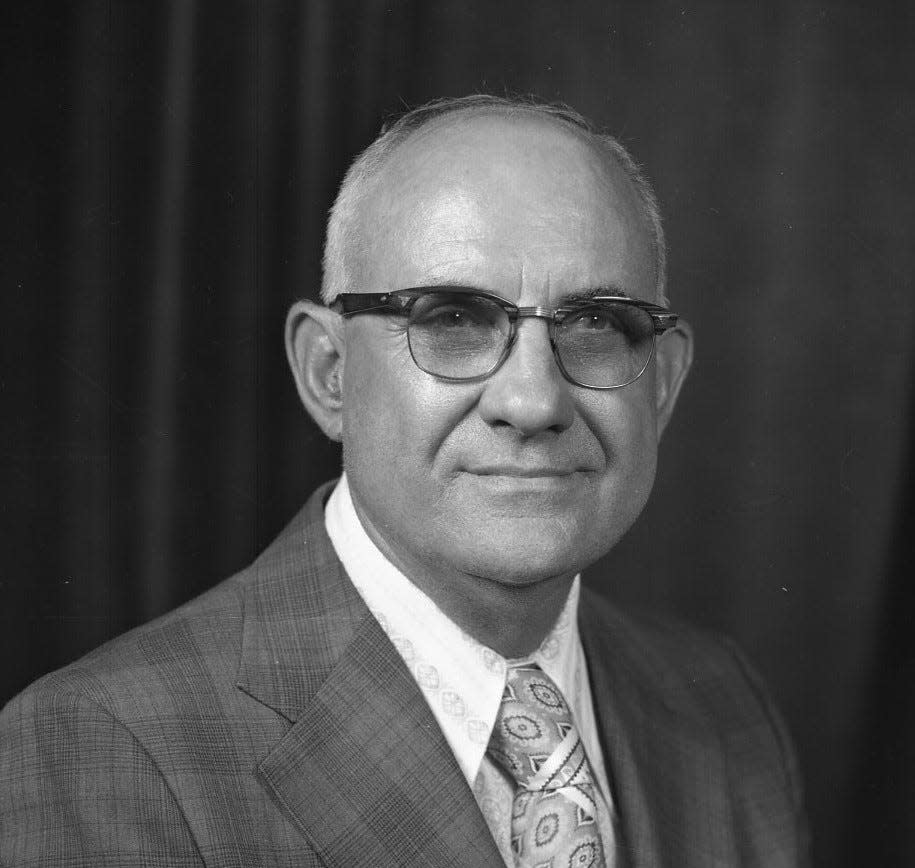Weston Wednesday: Bartlesville beginnings

Editor's Note: In collaboration with the Bartlesville Area History Museum, the Examiner-Enterprise has revived the late Edgar Weston's 'Revisiting the Past' columns that ran in the newspaper from 1997-99. Weston's columns recount the history of Bartlesville as well as Washington, Nowata and Osage counties.
Once the Santa Fe Railroad arrived, Bartlesville began to relocate near the railroad’s new depot. Business buildings were partly of new construction, but many were moved to Second Street and placed upon temporary foundations. The new construction was of a more permanent nature, but the small wood buildings were easily moved and very necessary to keep the town going. Drug stores, cafes, a leather and harness shop, a grocery, blacksmiths, livery barns, hay barns, granaries, lumber yards, hardware, coal yards, clothing stores and many others had to be established as the developing “oil boom” came into focus.
The area of present Fourth, Fifth, Sixth and Seventh Streets from Keeler to Cherokee became the residential area. Beyond that was the William Johnstone farm (where Central Middle School now resides). The area listed was called “On the Hill.” It was almost free of trees and homes sprung up rapidly.
Sam Bopst built a wood house on the northeast corner of Fourth and Johnstone Avenue. He built a wood corral that contained a stable, barn, chicken house and hog house. The corral fence was boards about four and a half feet high. They had a driving team, saddle horses, a milk cow, chickens and hogs.
Roy Bopst told me that the area to the Caney River could be seen from their house. All of the chickens and young pigs had to be shut in their houses at night to protect them from coyotes that roamed in packs, coming up to their barn lot and catching chickens and small pigs.
Roy said, “Many small houses were built in the area, some were all wood and some contained wood floors and siding up four to six feet then covered by a tent. Houses of any kind could be sold as fast as they could be built. It was almost impossible to rent any kind of house and many lived in covered wagons.”
Town lots in Bartlesville were leased for drilling oil and gas and standard drilling rigs sprung up on the west and east sides of the Santa Fe Railroad. The rigs covered many blocks across town. Photos of 1903 and 1904
of the east and west side look like a town of oil rigs.
At night, the chug, chug, chug of the sputters kept up a continuous noise all night, every night. The lights of the rigs could be seen across town and when drill bits were sharpened and reshaped, the ring of the sledge hammers could be heard across town. The streets and trails were all dirt and wind carried the dust everywhere in dry times. In wet times, the mud was knee-deep and the ruts full of water, so the wagons just moved over and made a new trail.
The leasing of land in large tracks was attempted by many developers, but the Department of Interior closed down leasing in the Cherokee Nation until the allotment of land was completed. Then any developer of oil leases had to lease the allotment from the individual allottee. Many who came to Bartlesville to get into oil and gas development gave up and left the area before the Cherokee Nation was released by the Department of Interior, some returned later.
The drilling continued on the town lots leased before the shutdown of leasing. Perhaps the shutdown period allowed many needed businesses to become established before the “Big Oil Boom” came to Bartlesville. The first City Hall, built in 1903 at Second and Keeler, put in place City Ordinances passed by the Town Council to control leasing town lots for oil and gas, carrying guns, allowing horses to roam at will in town, setting of fires in town, etc.
The beginning of construction on Third Street (now Frank Phillips Blvd.) lead to a better quality of buildings and more orderly development, creating more pride in Bartlesville as a first-class city.
It is almost unbelievable the amount of activity necessary to keep the Boom Town supplied. Hay and grain had to be taken to the livery barns and to drilling rigs, construction materials were needed everywhere, pipe, drilling equipment, and supplies were all necessary to operate. Food was a very real problem, the food had to be taken to the drill sites; lunch was taken in buggies or buckboards. Any way possible was used to keep the drilling rigs going and workers supplied.
Some of the old ledgers of drilling companies cover every manner of records. The lease location, the drilling of each well, supplies delivered to the site, break downs, fishing for tools lost in the hole, the names of all workers on each well, corn, oats, and hay used at the sites, the well depths, oil sands encountered, farmers living on the lease supplying food, and cost of the food. Always pipe, cable, and supplies of all kinds were listed.
Every day records of oil and gas wells are a very interesting read and one can almost get the feel of the operation. Sometimes the daily weather was even listed…snows, rainfall, heat, small incidents, and visitors to the well site, etc.
Sometimes we look upon Bartlesville, Dewey, Copan, Ramona, etc. and fail to see the real hardships encountered in their development. These folks had to have a certain determination to finish the task ahead. As we walk the old trails to oil leases and see the evidence of half a lifetime there, it causes us to reflect on the whole picture. Just how much of the extras did they ever enjoy?
This article originally appeared on Bartlesville Examiner-Enterprise: Weston Wednesday: Bartlesville beginnings

